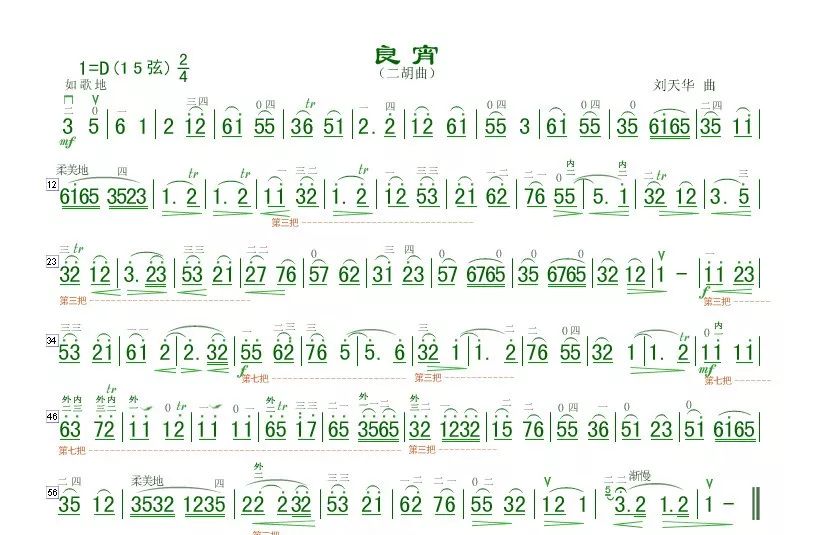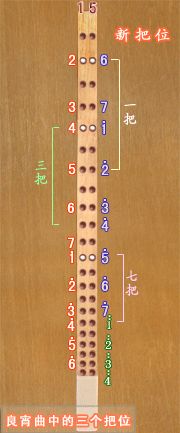Detailed graphic teaching of the famous Erhu song "Good Night"
The following is the notation of Erhu "Good Night". This piece is in the key of D, and the tuning is (1 5) string. The sheet music and exercises are explained as follows:

1. "Good Night" is performed using the following three positions

The three handle positions (1st, 3rd, 7th) shown above. That is the three playing positions required in the "Good Night" score.
2. The place to pay attention to when changing the song "Good Night"
1. Sections 15 and 45
Use open string changer
2. Sections 22-23

Swap handle
3. Sections 36-37

Use more fingers
4. Sections 18-20

Using a variety of switching methods
3. Points to be paid attention to in the fingering of the song "Good Night"
1. Sections 3, 4, etc.

little finger press
It is necessary to focus on practicing the pressing of the little finger in the first position, especially to clarify whether the "5" sound should be pressed with the outer string or the inner string with the little finger, which often depends on the requirements of melody and timbre. For little finger exercises, please refer to the pages of "Erhu Little Finger Pressing" and "Little Finger Shifting Exercises" on this website.
2. Sections 5, 13, etc.
sound practice
Use the middle finger "major second" technique. For practice on strumming, please refer to the 'Strumming Practice' page of this website.
3. Small third degree sliding finger skills
..bars 17, 34, 59
The slider of the minor third in the middle. To use the "slip finger" technique of expanding the ring finger down (without changing the handle), the portamento is required to be just right.
.. subsection 26 etc.
A minor third degree of sliding finger. Here, the middle finger is used to slide from the third to the first.
..bars 37, 38

A small three-degree slide finger up and down. Note that when the ring finger is sliding, the tiger's mouth should be stable in the seventh position (do not change the handle).
4. Section 35
Index finger up technique. The method of changing the handle is generally not used here, but the tiger's mouth is fixed on the third handle, and the index finger is extended (stretched) to press the "6" sound. Similar to the upward expansion of the index finger in the 50th bar (seventh position).
5. Sections 47 and 48
The second note here adopts the technique of "downward turn portamento".
4. Points for attention in the operation of the bowing method in "Good Night"
1. Sections 12 and 57

Complete the eight-note drawing in a smooth, one-bow.
2. Fingering of curved tail

Here, the sound "5" should start lightly, the three tones from "3" to "1" should be gradually strengthened, and the melody should gradually slow down. The last three notes of "121" should gradually weaken, and finally the "1" note should be ended with a bow.
5. The rhythm
1. Sections 13-14, etc.

Dotted quarter notes are generally three times as long and loud as eighth notes. There is a difference in timing between bars 13-14 and mid-tones in bar 16:
Quarter-dotted notes in bars 13 and 14 should be followed by a short rest (pause), while eighths should be played shorter and later. That is, when pulling the dotted sound in front, you can leave a little space, and the phrase will be more energetic. Generally, this kind of bowing method is often used when the dotted tone pattern appears repeatedly in the song. On the contrary, when the dotted pattern appears only once in the piece (such as the 16th bar), and if there is no dotted pattern before and after it, the bowing should be coherent at this time, and there should be no pause in the middle (except in a few cases).
2. Section 20

Pay attention to the precision of the rhythm. Similar to subsections 36, 39, 41, 44, etc. Count the beats correctly when practicing.
3. Sections 19-20

There are two connecting lines in the last three notes, the short one is the music connecting line or the sentence connecting line, and the long one above is the bowing connecting line. When playing, these three notes require one bow to complete. When carrying a bow, you must master the distribution of the bow segments in the first section. Similar to section 34 and so on.
6. Intonation
For learners with high requirements on intonation, in addition to paying attention to considering intonation from the perspective of tonality, they should also listen to the intonation relationship between tones from the perspective of pure-tempered tuning.

For example, when the three tones of "356" are pressed at the beginning of the whole piece, because the second sound "5" is a hollow string tone, it is very important to deal with the pressing of these tones from the perspective of erhu pure temperament tuning. Specifically, the first tone "3" should be pressed slightly higher (that is, the inner string of the middle finger is slightly inclined to "4"). The third note "6" should take into account the tonality of the song. There is a lot of knowledge in this area, and different scholars have different ways of dealing with it. As an erhu lover, listening to more records is a better way to improve your performance.
7. The most difficult part of "Good Night" to master the pitch
The most uncontrollable passage in the whole piece is the 45th-50th bar (seventh position). Its position and intonation practice can be easily practiced on the phoneme stick. When practicing, position the index finger on the silver-white hole in the middle of the phoneme stick, which is the correct seventh position. Practice for a few minutes every day, and you will master this part of the pitch.
 渝公网安备 50010702504639号
渝公网安备 50010702504639号